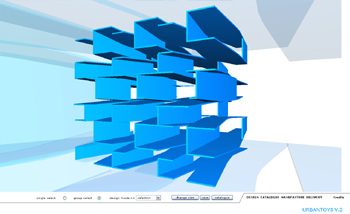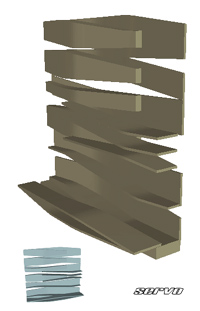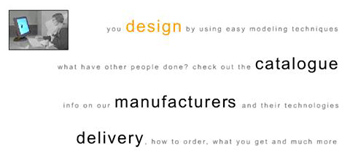updated October 04, 2008
Urbantoys

Urbantoys v2 design interface
Urbantoys
Urbantoys v.1 and v.2 are design environments that provide tools for the design of toys and domestic objects as well as architectural and urban systems via a series of manipulations of a digital model. Implicit in the word urban-toy is a fluctuation between an architectural scale and program and the scale and the program of a toy or hand held object. By submitting designs to and sampling designs from a catalogue, the visitors´ designs are made available to other potential authors. Catalogued urbantoys may be retrieved, produced and exhibited at a later event. The interface also enables the possibility for the visitor to directly engage with a manufacturer by ordering a rapid prototype of a designed object or environment. The design interface sets up a conversational terrain and diffuses the conventional roles of manufacturer, architect/designer and site visitor.
Servoline_1/urbantoys

Servoline_1/urbantoys design interface
In Servoline_1/urbantoys a whole series of techniques and methods are linked together; web-based 3D modelling (Cult3D), payment services for e-trading, design production and manufacture (Rapid Prototyping) distribution (TNT, DHL). Servoline1/Urban Toys is a new consumption model where the design process and the relation between consumer and manufacturer is transformed. The consumer becomes here a co-originator, producer and manufacturer.
The Urbantoys projects make use of software developed for on-line gaming environments, and looks for the extreme potential within these ready-made tools in order to establish the "design rules" of the generic but still specific design environments. While the Servoline_1/urbantoys uses a fairly simple and intuitive interface, well adapted to the on-line visitor, urbantoys v.2 functions on a more complex level, supported by the physical installation in the gallery space.
Urbantoys v.2

the Urbantoys v.2 physical installation
Urbantoys v.2 was a redevelopment of the Servoline_1/urbantoys project set in a gallery space, as part of the Iaspis Reshape sideshow of the 50th Venice biennale.
The gallery space required a spatial set up for the digital design environment; it performed as a platform for interaction, both literary in the design system, and through discussions between visitors. Physical models of previous designs were displayed, and other components provided the context for the less informative digital interface. The Urbantoys v.2 featured a back-lit table connected to a wall, carrying models, and protruding enabling visitors / users to gather around to handle the models and view “product specification” of previous designs, giving a context to the digital browser.
The Urbantoys v.2 project explores the possibilities of using a gallery space as a platform for participatory design where the authorship of a set of environments is distributed on the visitors. The visitor/ consumer of the piece is at the same time potentially a producer and author of designs that might be sampled by other visitors, as well as manufactured and exhibited at a later event. The audience involved in the consumption of the piece are at the same time performers of a creative act. Servo authors and producers of the installation might on the other hand be consumers of the visitors saved designs if they are manufactured and exhibited.
Servoline_1/urbantoys
project leader: Ulrika Karlsson and Marcelyn Gow/ Servo
design team: Daniel Norell, Jonas Runberger, Nina Lorber, Ulrika
Wachtmeister, Alice Dietsch, Johan Bohlin, Oskar Jonsson, John Stäck
Urbantoys v.2
project leader: Ulrika Karlsson / Servo
krets: Daniel Norell and Jonas Runberger
Database programming: Oskar Scheiwiller

Servoline_1/urbantoys diagram of operations